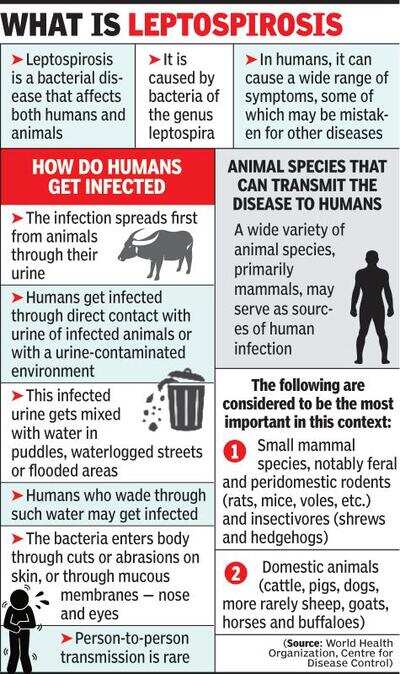- News
- City News
- nagpur News
- Zoonotic disease leptospirosis detected in dead Wardha buffaloes
Zoonotic disease leptospirosis detected in dead Wardha buffaloes

Nagpur: Wardha district officials have confirmed the presence of fatal zoonotic disease — leptospirosis — in samples obtained from dead buffaloes in their area. TOI was the first to report on August 25 about death of over half a dozen buffaloes within a span of one week in some tehsils of the district.
Leptospirosis is a zoonotic disease, which means it can spread from animals to people, and there is an established line of treatment for it. (see box)
Common among humans during monsoons, leptospirosis claims lives every year.
Infectious disease expert Dr Nitin Shinde said, “In Maharashtra, the maximum cases of leptospirosis and fatalities are registered in Mumbai. In Nagpur, deaths are rare but cases are reported every monsoon. The good news is that majority of cases can be treated, if diagnosed in time.”
The infection in humans can cause flu-like symptoms and also liver or kidney disease.
After officials stepped up the disease prevention campaign in Wardha, no new deaths have been reported nor has there been any case of animal-to-human transmission reported. Till the time of going to print, no official buffalo death figures were provided by authorities, but Hinganghat MLA Sameer Kunawar said 15 animals have died so far.
While leptospirosis has been detected in blood samples, Wardha collector Rahul Kardile confirmed that the fatal zoonotic disease was not present in urine samples. This, as per veterinarians, makes it very difficult for the disease to spread to humans.
“There is no need for panic among citizens. We have directed officials to ensure that preventive and monitoring measures are being implemented in full force,” said Kardile in an official statement.
Since leptospirosis has been detected in blood of dead buffaloes, there are a few things which humans around them have to take note of, according to district animal husbandry (DAH) office.
Dr Pradnya Daigavane-Gulhane, DAH officer (Wardha) said, “If there is a body injury to the buffalo where the skin is cut, then utmost care has to be taken by people who come in contact with them. Information about this has been sent to all villages through gram panchayats and our team working at the ground level.”
Leptospirosis is caused by rodents, said Dr Gulhane. “It’s these infected rodents who bite and then transmit the disease to buffaloes. So far, we have noticed this only in buffaloes and it’s most probably because buffaloes sit in muck a lot where such rodents thrive,” she added.
All villages have now been asked to provide daily health report of their cattle. “We are getting daily data of all bovines in villages. Line of treatment has been identified and many are already on path to recovery,” said Dr Gulhane.
The immediate task for district officials is tackling the cause. Dr Gulhane said, “Rodent control is a priority and the process is already on.”
Kunawar, who was the first to bring this issue to government’s notice, said now the state should ensure compensation for farmers. “I had met animal husbandry and fisheries minister Radhakrishna Vikhe-Patil on August 24, following which the entire government system started moving. The district authorities are doing a good job of creating awareness about this, which will help control the spread. Now, the government must announce financial compensation for those who have lost their livestock,” said Kunawar.
Leptospirosis is a zoonotic disease, which means it can spread from animals to people, and there is an established line of treatment for it. (see box)
Common among humans during monsoons, leptospirosis claims lives every year.
Infectious disease expert Dr Nitin Shinde said, “In Maharashtra, the maximum cases of leptospirosis and fatalities are registered in Mumbai. In Nagpur, deaths are rare but cases are reported every monsoon. The good news is that majority of cases can be treated, if diagnosed in time.”
The infection in humans can cause flu-like symptoms and also liver or kidney disease.
After officials stepped up the disease prevention campaign in Wardha, no new deaths have been reported nor has there been any case of animal-to-human transmission reported. Till the time of going to print, no official buffalo death figures were provided by authorities, but Hinganghat MLA Sameer Kunawar said 15 animals have died so far.
While leptospirosis has been detected in blood samples, Wardha collector Rahul Kardile confirmed that the fatal zoonotic disease was not present in urine samples. This, as per veterinarians, makes it very difficult for the disease to spread to humans.
“There is no need for panic among citizens. We have directed officials to ensure that preventive and monitoring measures are being implemented in full force,” said Kardile in an official statement.
Since leptospirosis has been detected in blood of dead buffaloes, there are a few things which humans around them have to take note of, according to district animal husbandry (DAH) office.
Dr Pradnya Daigavane-Gulhane, DAH officer (Wardha) said, “If there is a body injury to the buffalo where the skin is cut, then utmost care has to be taken by people who come in contact with them. Information about this has been sent to all villages through gram panchayats and our team working at the ground level.”
Leptospirosis is caused by rodents, said Dr Gulhane. “It’s these infected rodents who bite and then transmit the disease to buffaloes. So far, we have noticed this only in buffaloes and it’s most probably because buffaloes sit in muck a lot where such rodents thrive,” she added.
All villages have now been asked to provide daily health report of their cattle. “We are getting daily data of all bovines in villages. Line of treatment has been identified and many are already on path to recovery,” said Dr Gulhane.
The immediate task for district officials is tackling the cause. Dr Gulhane said, “Rodent control is a priority and the process is already on.”
Kunawar, who was the first to bring this issue to government’s notice, said now the state should ensure compensation for farmers. “I had met animal husbandry and fisheries minister Radhakrishna Vikhe-Patil on August 24, following which the entire government system started moving. The district authorities are doing a good job of creating awareness about this, which will help control the spread. Now, the government must announce financial compensation for those who have lost their livestock,” said Kunawar.
FOLLOW US ON SOCIAL MEDIA
FacebookTwitterInstagramKOO APPYOUTUBE
Start a Conversation
end of article









